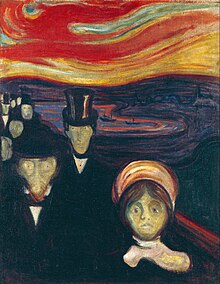BMI, Puberty, and Mood
 From Wikiversity - Reading time: 7 min
From Wikiversity - Reading time: 7 min

Body mass index (BMI) and puberty are both correlated with mood disorders (such as depression, bipolar disorders), negative affect and anxiety. Puberty itself is associated with changes in BMI and body shape, and some of the psychosocial stress associated with puberty is likely due to body dissatisfaction. Pubertal onset is correlated with changes in BMI as well as mood disorders and negative affect. These findings have been replicated in a number of ethnicities and across sexes.
Puberty and BMI
[edit | edit source]The General Relationship
[edit | edit source]
Many studies have looked at the general relationship between timing of pubertal onset and associated changes in BMI. A longitudinal study of Swedish children from birth to age 18 found a correlation between childhood nutritional status, measured by BMI, and timing of pubertal onset. In general, a 1 BMI unit increase is associated with puberty beginning, on average, 0.11 years earlier.[1]
National Institute of Child Health and Human Development Study of Early Child Care and Youth Development
[edit | edit source]The NICHD Study of Early Child Care and Youth Development has been widely used to investigate the gender-specific relationship between childhood body mass index and pubertal onset. In girls, higher BMI at age 36 months and a higher rate of change in BMI between age 36 months and grade 1 are both associated with earlier onset of puberty. Further, animal studies have demonstrates that restriction of weight gain delays the timing of puberty. The implication, then, of these findings is that weight gain and resultant BMI increases are critical for the initiation of puberty.[2] The same study in boys found opposite results. In boys, higher BMI during early to middle childhood (until age 11.5 years) was found to be associated with a later onset of puberty. The stark difference in findings across genders suggests that leptin, one of the many hunger signaling molecules in the body, is working differently in boys than in girls. It would follow that boys with higher BMI should have a higher leptin level and therefore should demonstrate earlier puberty. These two points are reconciled when considering the rate of change of leptin in boys versus girls. Whereas leptin levels continue to rise in girls during puberty, they drop off sharply in boys. It is hypothesized that this decrease is required for earlier pubertal onset.[3]
Causality
[edit | edit source]Causality between BMI and puberty has been investigated in girls, specifically. Evidence suggests that obesity (and as a result, higher BMI) may be causally related to earlier puberty rather than earlier puberty causing an increase in BMI. A causative link between body fat and the reproductive axis in girls is supported by evolution. It is likely that the causative link evolved as a mechanism to ensure that pregnancy cannot occur unless there are enough fat stores to ensure sustenance for both the mother and the growing fetus. In boys, causality has not been found and there is no evolutionary mechanism, of yet, that would seem to explain higher BMI resulting in later pubertal onset.[4]
Puberty as a Correlate for Depressed Mood
[edit | edit source]Overweight Perception
[edit | edit source]The physical changes associated with puberty typically cause teens to re-evaluate their self-image, particularly in regards to body image.[5] Puberty, in general, has a number of adjustment risks when it entails the perception of being overweight including depressed mood, somatic complaints, and low self-esteem.
Gender Differences
[edit | edit source]Weight gains associated with pubertal development have a significant relationship to the perception of being overweight, especially among girls. Specifically, overweight perception has been shown to increase risk of depression, somatic complaints, and low self-esteem in girls. Boys are generally less likely to perceive themselves as overweight during pubertal development probably because much of their weight gain (and therefore BMI gain) is in the form of muscle mass. Nevertheless, boys also show increased risk for depressed affect if they perceive themselves to be overweight and also show higher risk for low self-esteem compared to their female counterparts. Boys generally do not demonstrate somatic complaints.
Ethnic Differences
[edit | edit source]Perhaps more pronounced than gender differences in overweight perception are the differences across ethinicities. General findings indicate that the perception of being overweight has more negative effects on Anglo adolescents' emotional health compared to their Hispanic-American and African-American counterparts. Overweight perception appears to increase the risk of depressed affect among Anglo-American and Hispanic-American adolescents but not among African-American adolescents. In line with these findings, somatic complaints seem to be prevalent among Anglo-American and Hispanic-American adolescents but not among African-American adolescents. Overweight perception seems to impact self-esteem across all ethnicities but has the most negative effects in Anglo-Americans.
Perception of Pubertal Onset
[edit | edit source]
As was the case with overweight perception. Perception of pubertal onset (being an early, normal, or later developer) is also related with increased risk of depressed affect and somatic complaints.[6] Self esteem, however, is relatively unaffected by perceived pubertal timing.[6]
Gender and Ethnic Differences
[edit | edit source]General Gender Differences
[edit | edit source]Among girls, perception of having matured early appears to increase risk for both depressed affect and somatic complaints. For boys, on the other hand, being a late maturer appears to increase risk for a negative response. Of note is that fact that controlling for body image eliminates these vulnerabilities across both genders. The implication is that perception of body image is likely what is driving someone to perceive themself as being an early, late, or normal developer.
Gender Differences Across Ethnicities
[edit | edit source]The ethnic differences in perception of pubertal onset are driven largely by gender differences. White teenage girls responded negatively to early development but not to normal or late development. White boys seemed relatively unaffected by perceived pubertal onset since perception of onset did not result in any differences in affect or body satisfaction. Hispanics show perhaps the most pronounced differences across genders. Girls show more positive affect if they perceive themselves as having developed on time rather than early or late. Hispanic boys, on the other hand, show more positive affect not only if they perceive themselves as having developed on time but also if they perceive themselves as early developers. Among African-Americans, both boys and girls were least satisfied with their bodies if they perceived themselves as late developers. Just as with overweight perception, the results for African-Americans appear once again to be divergent as they are the only ethnicity in which late development was favored over early or on time development. Of all the ethnic groups studied, Asian Americans demonstrated the most interesting results. Asian Americans were the only group for which onset of puberty was unrelated to body satisfaction or depressed affect.
The Thin Ideal
[edit | edit source]
Many of the above findings suggest that much of the psychological dysfunction associated with puberty and BMI is the result of the pervasive thin ideal. The thin ideal sets the standard that the ideal body shape for a female is thin and curvaceous[6] and that for a male is slender and muscular.[5] The finding that girls respond more negatively to being earlier developers indicates that they prefer their prepubescent body and would therefore prefer to delay puberty (during which time BMI will inevitably increase).[6] Additionally, the fact that boys show elevated risk of low self-esteem if they perceive themselves to be overweight seems to indicate that they too are responding to the thin ideal.[5] A particularly interesting piece of evidence that supports the role of the thin ideal is that foreign-born Asian-Americans have a more positive body image than US-born Asian-Americans. The implication of this finding is that foreign-born Asian-Americans may be less responsive to, and more insulated from, the thin ideal especially if they were born in a country in which the thin ideal is less pervasive.[5]
The Case of African-Americans
[edit | edit source]Numerous studies have indicated that African-Americans diverge in their perception of body shape/size and pubertal onset compared to other ethnicities. African-Americans seem to show an inverse relationship between body perception and psychological maladjustment wherein perception of being overweight appears to insulate African-Americans from psychological maladjustment.[5] African-Americans appear to take pride in their bodies, irrespective of shape or size. In this way, they set themselves apart from other teenagers.[6] African-Americans in general seem less sensitive to matters of weight gain and are more immune to the thin ideal.[6]
Weight Loss/Control Behaviors
[edit | edit source]Among 9 year old Canadian children, weight loss and weight control behaviors can be effectively predicted by pubertal onset and peer pressure. Since pubertal onset can predict BMI and body shape, it follows that pubertal onset and perception of pubertal onset can lead to maladapative weight loss and control behaviors.[7]
Among adolescents, peer pressure and negative comments become stronger predictors of weight loss and weight control behavior as well as the frequency of such behaviors. Although body dissatisfaction itself does not predict maladaptive behavior, it does correlate with negative comments from peers regarding weight. Therefore, perception of being overweight, and reinforcement of this perception by peers, can lead to maladaptive weight loss and control behaviors.[7]

If such maladaptive behaviors continue they can serve as a gateway to clinically significant symptoms that may warrant an eating disorder diagnosis.
References
[edit | edit source]- ↑ He, Qing; Karlberg, Johan (2001-2). "BMI in Childhood and Its Association with Height Gain, Timing of Puberty, and Final Height". Pediatric Research 49 (2): 244–251. doi:10.1203/00006450-200102000-00019. ISSN 0031-3998. http://www.nature.com/doifinder/10.1203/00006450-200102000-00019.
- ↑ Lee, J. M.; Appugliese, D.; Kaciroti, N.; Corwyn, R. F.; Bradley, R. H.; Lumeng, J. C. (2007-03-01). "Weight Status in Young Girls and the Onset of Puberty". PEDIATRICS 119 (3): e624–e630. doi:10.1542/peds.2006-2188. ISSN 0031-4005. http://pediatrics.aappublications.org/cgi/doi/10.1542/peds.2006-2188.
- ↑ Lee, Joyce M.; Kaciroti, Niko; Appugliese, Danielle; Corwyn, Robert F.; Bradley, Robert H.; Lumeng, Julie C. (2010-02-01). "Body Mass Index and Timing of Pubertal Initiation in Boys". Archives of Pediatrics & Adolescent Medicine 164 (2). doi:10.1001/archpediatrics.2009.258. ISSN 1072-4710. PMID 20124142. PMC PMC4172573. http://archpedi.jamanetwork.com/article.aspx?doi=10.1001/archpediatrics.2009.258.
- ↑ Kaplowitz, Paul B. (2008-2). "Link Between Body Fat and the Timing of Puberty". Pediatrics 121 (Supplement 3): S208–S217. doi:10.1542/peds.2007-1813F. ISSN 0031-4005. http://pediatrics.aappublications.org/lookup/doi/10.1542/peds.2007-1813F.
- ↑ 5.0 5.1 5.2 5.3 5.4 Ge, Xiaojia; Elder, Glen H.; Regnerus, Mark; Cox, Christine (2001). "Pubertal Transitions, Perceptions of Being Overweight, and Adolescents' Psychological Maladjustment: Gender and Ethnic Differences". Social Psychology Quarterly 64 (4): 363–375. doi:10.2307/3090160. ISSN 0190-2725. https://www.jstor.org/stable/3090160.
- ↑ 6.0 6.1 6.2 6.3 6.4 6.5 Siegel, Judith M.; Yancey, Antronette K.; Aneshensel, Carol S.; Schuler, Roberleigh (1999-08-01). "Body image, perceived pubertal timing, and adolescent mental health". Journal of Adolescent Health 25 (2): 155–165. doi:10.1016/S1054-139X(98)00160-8. ISSN 1054-139X. PMID 10447043. https://www.jahonline.org/article/S1054-139X(98)00160-8/abstract.
- ↑ 7.0 7.1 Tremblay, Line; Lariviere, Michel (2009-04-01). "The influence of puberty onset, Body Mass Index, and pressure to be thin on disordered eating behaviors in children and adolescents". Eating Behaviors 10 (2): 75–83. doi:10.1016/j.eatbeh.2008.12.001. ISSN 1471-0153. http://www.sciencedirect.com/science/article/pii/S1471015308000998.
 KSF
KSF